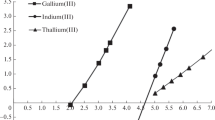Abstract
Tellurium (Te) demonstrates properties similar to those of elements known to be toxic to humans, and has applications in industrial processes, which are rapidly growing in importance and scale. It is relevant, therefore, to consider the tellurium physiology, toxicity, and methods for monitoring the element in biological and environmental specimens. Animal studies suggest that up to 25% of orally administered tellurium is absorbed in the gut. There is a biphasic elimination from the circulation with loss of about 50% within a short period,t 1/2=0.81 d, and slower elimination of the residual Te,t1/2=12.9 d. Following a single ip, injection the largest proportion is in the kidney and bone, but with repeated oral administration, Te is found in the heart ≫ kidney, spleen, bone, and lung. Formation of dimethyl telluride is a characteristic feature of exposure, and gives a pungent garlic-like odor to breath, excreta, and the viscera. The main target sites for Te toxicity are the kidney, nervous system, skin, and the fetus (hydrocephalus). Te can, be reliable measured in different specimens by several analytical techniques. Recent work has employed hydride generation atomic absorption spectrometry. Topics for further investigation are proposed.
Similar content being viewed by others
References
G. D. Clayton and F. E. Clayton, eds.,Patty's Industrial Hygiene and Toxicology, John Wiley, Chichester (1981).
A. Taylor, Biochemistry of tellurium, inNew Perspectives in the Research of Hardly Known Trace Elements, I. Pais, ed., Budapest University of Horticulture and Food Science, Budapest, Hungary, pp. 147–158 (1994).
R. H. De Maeio, Tellurium. I. The toxicity of ingested elementary tellurium for rats and rat tissues,J. Ind. Hyg. Toxicol. 28, 229–232 (1946).
J. G. Hollins, The metabolism of tellurium in rats,Health Phys. 17, 497–505 (1969).
E. A. Cerwenka and W. C. Cooper, Toxicology of selenium and tellurium and their compounds.Arch. Environ. Health 3, 189–200 (1961).
H. Kilpatrick, The absorption, distribution and excretion of tellurium dioxide. MSc Thesis, University of Surrey (1994).
W. F. Agnew, Transplacental uptake of 127m-Tellurium studied by whole-body autoradiography.Teratology 6, 331–338 (1972).
A. J. Larner, Biological effects of tellurium: A review.Trace Elements Electrolytes 12, 26–31 (1995).
W. Reisert, The so-called bismuth breath.Am. J. Pharmacol. 56, 177–180 (1884).
K. W. Franke and A. L. Moxon, The toxicity of orally ingested arsenic, selenium, tellurium, vanadium and molybdenum.J. Pharmacol. 61, 89–102 (1937).
H. H. Steinberg, S. C. Massari, A. C. Miner, and R. Rink, Industrial exposure to tellurium: Atmospheric studies and clinical evaluation.J. Ind. Hyg. Toxicol. 24, 183–192. (1942).
B. Welz, M. S. Wolynetz, and M. Verlinden, Interlaboratory trial on the determination of selenium in lyophilised human serum, blood and urine using hydride generation atomic absorption spectrometry,Pure Appl. Chem. 59, 927–936 (1987).
HSE, Arsenic and inorganic compounds of arsenic in air, MDHS 41, HMSO, London (1984).
A. Taylor and H. Kilpatrick, Measurement of tellurium in environmental and biological samples by hydride generation atomic absorption spectrometry, inMetal Elements in Environment, Medicine and Biology, Z. Garban and G. Daranyi, eds, Timisoara University of Agricultural Sciences Timisoara, Romania, pp. 231–234 (1995).
R. A. Newman, S. Osborn, and Z. H. Siddik, Determination of tellurium in biological fluids by means of electrothermal vaporization-inductively coupled plasma-mass spectrometry,Clin. Chim. Acta. 179, 191–196 (1989).
A. Taylor, S. Branch, H. Crews, D. J. Halls, and M White, Atomic Spectrometry Update. Clinical and biological materials, foods and beverages,J. Anal. Atomic Spectrom. 11, 103R-186R (1996).
P. Lampert, F. Garro, and A. Pentschew, Tellurium neuropathy,Acta Neuropathol. 15, 308–317 (1970).
L. D. Mead and W. J. Gies, Physiological and toxicological effects of tellurium compounds,Am. J. Physiol. 5, 104–149 (1901).
R. H. De Maeio and W. W. Jetter, Tellurium. III. The toxicity of ingested tellurium dioxide for rats.J. Ind. Hyg. Toxicol. 30, 53–58 (1948).
M. L. Amdur, Tellurium dioxide. An animal study in acute toxicity,AMA Arch. Ind. Health 17, 665–667 (1958).
H. A. Schroeder and M. Mitchener, Selenium and tellurium in rats: Effect on growth, survival and tumors,J. Nutr. 101, 1531–1540 (1971).
H. A. Schroeder and M. Mitchener, Selenium and tellurium in mice. Effects on growth, survival and tumors,Arch. Environ. Health,24, 66–71 (1972).
L. N. El'Nichnykh and V. G. Lenchenko, Histomorphological changes in animal organs during poisoning with tellurium compounds,Klin. Patog. Profil. Zabol. Khim. Etiol. Predpr. Tsvet. Chern. Med. 169;2, 155–160 (1969) (Chemical Abstracts 74, 97299T): [1969].
W. W. Carlton and W. A. Kelly, Tellurium toxicosis in Pekin ducks,Toxicol. Appl. Pharmacol. 11, 203–214 (1967).
J. H. H. Keall, N. H. Martin, and R. E. Tunbridge, Three cases of accidental poisoning by sodium tellurite,Br. Jo. Ind. Med. 3, 175 (1946).
R. L. Webster, Washington Agricultural Experimental Station Circular No. 64 (1950) (Chemical Abstracts [1950]: 44, 5511).
International Labor Office. Occupation and Health, ILO, Geneva,2, 1009 (1934).
Author information
Authors and Affiliations
Rights and permissions
About this article
Cite this article
Taylor, A. Biochemistry of tellurium. Biol Trace Elem Res 55, 231–239 (1996). https://doi.org/10.1007/BF02785282
Received:
Accepted:
Issue Date:
DOI: https://doi.org/10.1007/BF02785282




